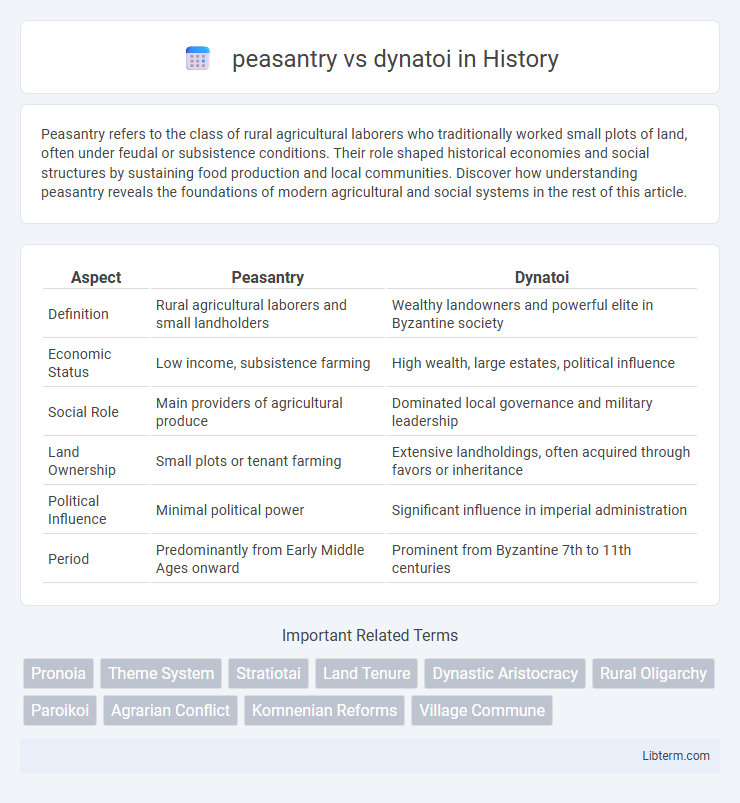Peasantry refers to the class of rural agricultural laborers who traditionally worked small plots of land, often under feudal or subsistence conditions. Their role shaped historical economies and social structures by sustaining food production and local communities. Discover how understanding peasantry reveals the foundations of modern agricultural and social systems in the rest of this article.
Table of Comparison
| Aspect | Peasantry | Dynatoi |
|---|---|---|
| Definition | Rural agricultural laborers and small landholders | Wealthy landowners and powerful elite in Byzantine society |
| Economic Status | Low income, subsistence farming | High wealth, large estates, political influence |
| Social Role | Main providers of agricultural produce | Dominated local governance and military leadership |
| Land Ownership | Small plots or tenant farming | Extensive landholdings, often acquired through favors or inheritance |
| Political Influence | Minimal political power | Significant influence in imperial administration |
| Period | Predominantly from Early Middle Ages onward | Prominent from Byzantine 7th to 11th centuries |
Introduction to Peasantry and Dynatoi
Peasantry refers to the class of rural farmers and laborers who primarily engaged in subsistence agriculture and local trade, forming the backbone of the medieval economy. Dynatoi, in contrast, were powerful landowners and aristocrats who controlled extensive estates and wielded significant political and military influence within Byzantine society. The tension between peasantry and dynatoi often shaped social structures, economic policies, and land reforms throughout Byzantine history.
Historical Context: Byzantine Society
In Byzantine society, the peasantry formed the backbone of the agrarian economy, primarily consisting of small-scale farmers who cultivated land under various obligations, while the dynatoi represented a powerful class of wealthy landowners and military aristocrats with extensive estates and significant influence in imperial administration. This socioeconomic divide deepened after the 7th century, as dynatoi accumulated more land through borrowing and taxation privileges, often displacing peasant proprietors and increasing rural dependency. The tension between peasantry and dynatoi shaped Byzantine land policies and contributed to the empire's evolving feudal structures, affecting military recruitment and economic stability.
Defining the Peasantry: Roles and Status
The peasantry in medieval societies primarily consisted of small-scale farmers and laborers who cultivated land and provided the economic foundation through agricultural production. They were often bound by obligations to landowners or the state, reflecting a lower social status but crucial economic role. In contrast, dynatoi represented the wealthy elite or powerful landowners with significant political influence and control over large estates.
Who Were the Dynatoi? Origins and Influence
The Dynatoi were a powerful class of wealthy landowners and military elites in the Byzantine Empire, emerging prominently from the 8th century onward. Originating from aristocratic families and high-ranking officials, they accumulated vast estates and significant political influence, often challenging the traditional peasantry's economic stability. Their dominance reshaped social structures by consolidating land ownership and weakening the free peasantry, contributing to the Empire's shifting power dynamics.
Land Ownership and Economic Power
Peasantry primarily held small, fragmented plots of land, limiting their economic influence and making them vulnerable to fiscal pressures and tenancy obligations. In contrast, the dynatoi, a powerful landed aristocracy, controlled vast estates that generated significant agricultural surplus and wealth, consolidating their political and economic dominance. This disparity in land ownership created a structural divide, with the dynatoi exercising control over rural economies and peasant labor.
Social Mobility and Class Barriers
Peasantry in medieval and Byzantine societies faced significant class barriers that limited social mobility, as land ownership and political influence were predominantly controlled by the dynatoi, or powerful landowning elites. While peasant families were largely tied to subsistence farming and owed obligations to dynatoi landlords, the dynatoi leveraged wealth and connections to consolidate power and maintain hierarchical dominance. Occasional instances of upward mobility occurred through military service or imperial favor, but these remained exceptional against the rigid class stratification prevailing in agrarian economies.
Legal Distinctions and State Policies
Legal distinctions between peasantry and dynatoi in Byzantine society centered on land ownership and tax obligations; peasants were typically small-scale landholders or tenant farmers with limited political rights, while dynatoi, as powerful landowning elites, held extensive estates and enjoyed privileges including tax exemptions and judicial immunity. State policies often favored the dynatoi to secure military and administrative support, leading to land concentration and weakening peasant autonomy. Imperial legislation, such as laws issued under Emperor Basil II, aimed to protect peasant land rights but frequently struggled against the growing influence and legal maneuvering of the dynatoi class.
Conflicts and Tensions between Peasants and Dynatoi
Conflicts between peasants and dynatoi in Byzantine society stemmed from competing interests over land ownership and economic control, with peasants seeking to maintain small holdings while dynatoi expanded estates through acquisitions and tax privileges. Tensions escalated as dynatoi enforced oppressive leases and taxes, leading to peasant indebtedness and loss of autonomy, undermining rural stability. The resulting social friction contributed to periodic revolts and imperial efforts to legislate protections for peasants against dynatoi encroachment.
Impact on Byzantine Stability and Decline
The growing power of the dynatoi, wealthy landowning elites, undermined the economic and social stability of the Byzantine peasantry by concentrating land ownership and diminishing smallholder independence. This shift weakened the empire's military recruitment base since peasant farmers traditionally supplied troops, leading to reduced local defense capabilities and increased vulnerability to external threats. Consequently, the imbalance between the dynatoi and peasantry contributed significantly to fiscal strain, social unrest, and the gradual decline of centralized Byzantine authority.
Legacy of the Peasantry-Dynatoi Divide
The legacy of the Peasantry-Dynatoi divide shaped the socio-economic landscape of the Byzantine Empire, reinforcing a hierarchical structure that favored wealthy landowners and marginalized small farmers. Dynatoi, powerful landholding elites, amassed extensive estates, often at the expense of the peasantry's land and autonomy, leading to increased rural inequality and social stratification. This divide contributed to long-term economic disparities and weakened the empire's capacity for military and agricultural resilience.
peasantry Infographic

 libterm.com
libterm.com